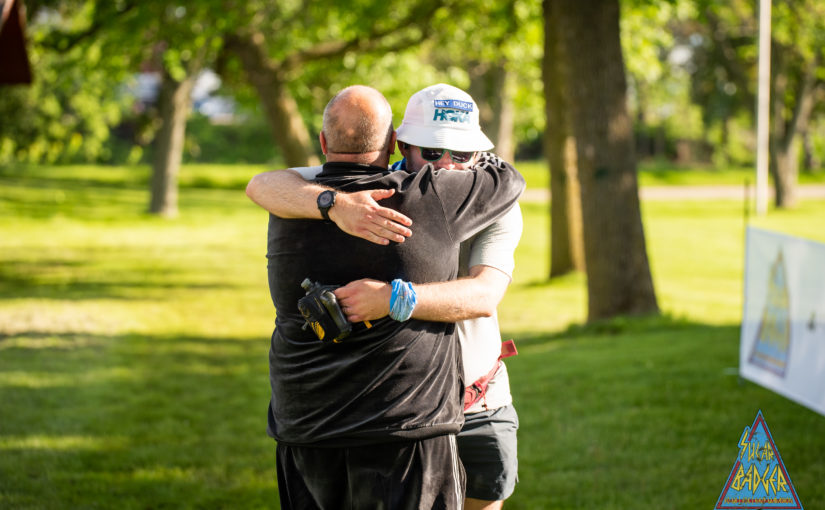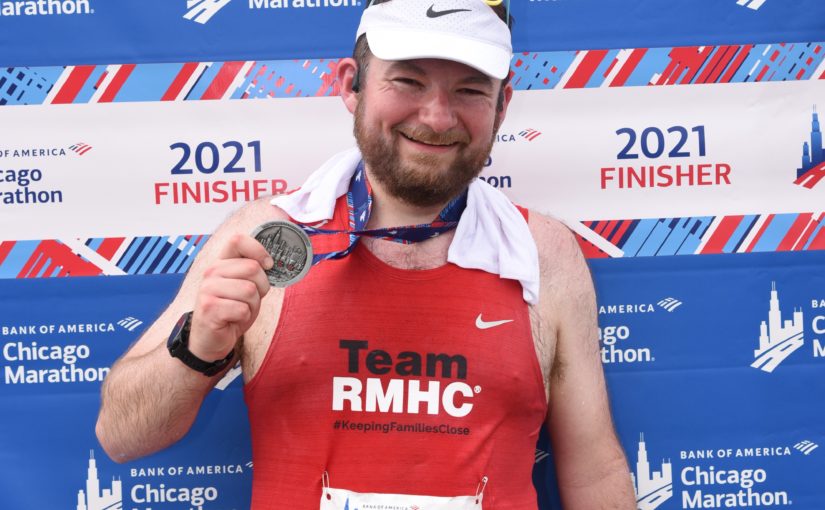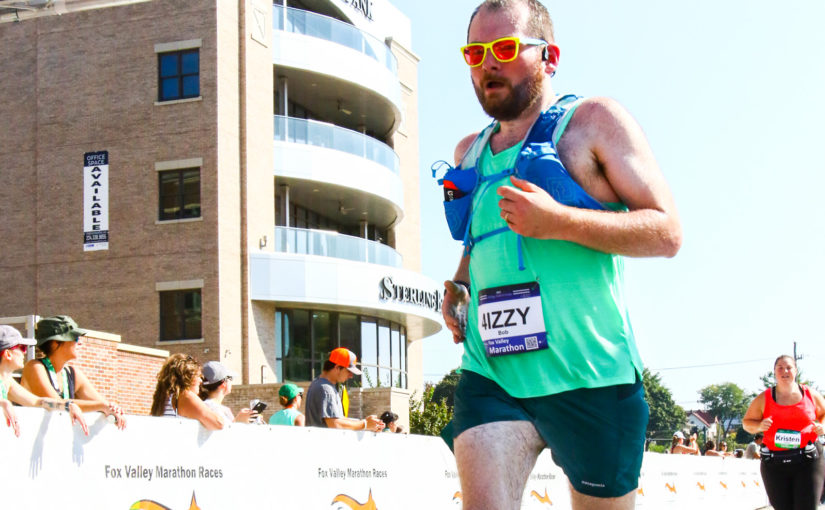NOTE: I dated this post back to when I originally wrote it (5/30/2022). Original publishing date on TeamPumaKnife.com is 8/6/2022.
Race Information
- Name: Sugar Badger 50M
- Date: May 28, 0222
- Distance: 52 Miles
- Location: Belleville, WI
- Website: https://www.tenjunkmilesracing.com/sugarbadger
- Strava: https://www.strava.com/activities/7218712522
- Time: 11:54:25
Goals
| Goal | Description | Completed? |
|---|---|---|
| A | Finish! | Yes |
| B | Sub 12 | Yes |
| C | Sub 11 | No |
Official Splits
| Mile | Time |
|---|---|
| 9.46 | 1:50:51 |
| 42.48 | 7:26:11 |
| 9.46 | 2:37:14 |
Strava Timings
| Leg | Dist | Time | Notes |
|---|---|---|---|
| 1 | 3.82 | 0:44:18 | |
| 2 | AS | 0:01:17 | |
| 3 | 5.64 | 1:05:33 | —————————- |
| 4 | AS | 0:02:12 | |
| 5 | 6.47 | 1:12:22 | |
| 6 | AS | 0:06:03 | Unreasonably Nice Running |
| 7 | 4.92 | 0:56:26 | |
| 8 | AS | 0:02:21 | |
| 9 | 5.06 | 0:59:13 | ————————— |
| 10 | AS | 0:19:48 | Turnaround – Changed shirt/socks – had a hot dog |
| 11 | 5.07 | 1:03:35 | Also very good, fidgeting with shoes/socks |
| 12 | AS | 0:02:07 | |
| 13 | 4.95 | 1:04:49 | Started to slow |
| 14 | AS | 0:01:49 | |
| 15 | 6.48 | 1:31:55 | Switched from 4/2 – 3/3 run/walk |
| 16 | AS | 0:03:10 | Hey Duck |
| 17 | 5.65 | 1:26:37 | Noticed Blister, popped in shoe, slowed me to walk for pretty much rest of race |
| 18 | AS | 0:06:03 | I owe someone a shot for not taking one here |
| 19 | 3.84 | 1:10:07 |
Training
I used the 50M training plan from Krissy Moehl’s “Running Your First Ultra”. The plan calls to run 5 days a week most weeks. I modified the plan to accommodate the Earth Day 50K which was a few weeks off of the “ideal” 50K in the plan. I found the plan challenging, but then again, I didn’t expect it to be easy to get me to 50 miles on race day. The training plan did not call for much in the way of training a walk/run plan, but I would need to, so in the last month of training I did a couple of runs, including my 25 miles run, doing a 4/2 run/walk. Training was generally pretty well but I definitely was feeling the fatigue of continuous training for the past year on my body. My left IT band was speaking to me a bit, and my right achilles was acting up. I began stretching every night, and started rotating in Hoka Bondi 7’s with my Brooks Ghost 14’s. These measures helped a lot and I started getting better without having to take a full on break. My last major training run was a 20 miler with the run club. It started off really well, but it got hot towards the end and I was overheating. I was a little demoralized at first, but I was able to use the data from that run to really create a good pace plan for the Sugar Badger, which, as I’ll cover below, worked well. Overall, successful training cycle.
Pre-race
I camped at the start/finish the night before and really struggled to sleep. I anticipated this, so I did my best to sleep well the entire week leading up to it. I struggled to get myself together in the morning and ended up rushing. Amazingly, in my rushing I didn’t forget anything, but it was more stress than I needed. Lesson learned on prep going forward. I had some manner of pastry from the food truck, a Clif Blok, and a quick gulp of coffee seconds before the race started.
Race Plan
I planned to follow a 4 min run / 2 min walk from the start and maintain that as far as I could. I was aiming for 11:45 miles through the turnaround – with AS breaks accumulated 12:30 pace. I figured out that if I got to the turnaround at that pace, which I was confident I could do, I would finnish even if I ended up having to walk the rest. In reality, I was very confident I would get through 35 miles without too much trouble based on my training runs. But even still, there was 21 more miles to cover than I had done before, so even though I felt comfortable to get to 35 I had no idea what would happen after that. Finishing was top priority, but I really wanted to finnish under 12 hours. This race has a generous cutoff of 14 hours, but I’ve heard many if not most other 50’s have 12 hour cutoffs – and on top fo that, if I finnished in 12 hours I would qualify to enter the Vermont 100 lottery. I didn’t bother trying to make a plan that would give me even splits the whole time. Experience has tought me that for my first race at this distance that would not happen. So, my race plan did account for dropping pace down to ~13:30 in the later stages.
Gear
For my top, I ran the first half in a Path Cascade SS t-shirt, and the second half I switched to a Path Unita Airdot Mesh t-shirt. Shorts, Path Crest PX 5″ shorts. Liner, XOSKIN 3.1 Underwear midi length. Socks, Xoskin XOTOes. Out I used Crew length, return I used quarter crew. I wore Hoka Bondi 7’s with Dirty Girl Gaiters. For my head, I used a Hoka bucket hat.
I originally planned to run with my vest. But after numerous runs with just my UltrAspire Synaptic waist pack I was really tempted to wear that instead and carry my Nathan Handheld. It would mean 300ml less fluid on me, but my gut told me that it was worth the trade off. After consulting some running folks online, I decided the day before to make the switch. This was dangerously close to breaking the golden rule of racing – because I had never used the wasit pack for a truly long run – but I had run with it enough that I felt ok with the risk. the biggest problem with the switch was needing to switch my drop bag strategy at the last minute which caused some choas race morning.
Course
The Sugar Badger takes place on the Badger State Trail and the Sugar River Trail in southern Wisconsin and it is an out and back – 26 out, 26 back. It is a rail-trail, super flat beautiful running surface. There is one significant hill right after/before the first/last aid station.
Race
I resisted the urge to run to the tunnel (3.82 miles) and stuck to my run/walk plan right from the gun. It was very amusing the first interval to start off relatively quickly and then have half the field pass me in a matter of 2 minutes. After the first intervals I did play leapfrog with a couple of groups of runners for a while, almost all the way through the first 20 before we fully got separation. For me, I really don’t hit my stride until mile 4, and same was true for this race. Which worked out really nicely because the first aid station is at 3.82. My pacing was about spot on, but my RPE was higher than I wanted – not dramatically, noticable. Hitting the AS and then going up the hill gave me the nice calming that I needed.
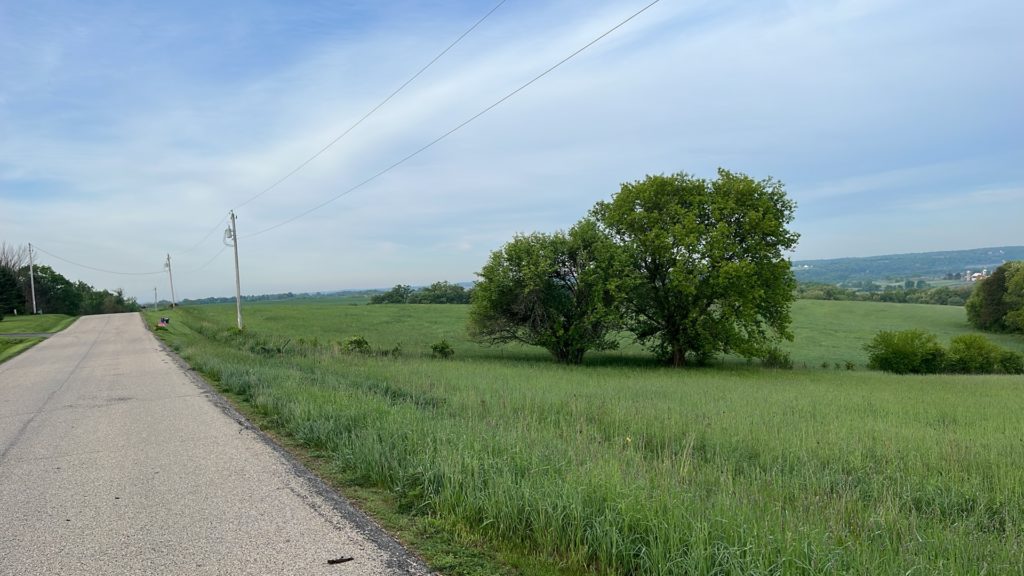
From the first Aid Station (2) all the way through the turnaround (10) it was smooth sailing. I had breakfast pizza at the Hollywood Aid Station (4) and amused the TJM folks with my “Hey Duck” name tape on my hat (listen to the Ten Junk Miles “Hey Duck” podcast episode if you’re curious). I had one bathroom break at the next aid station (6), otherwise I was speedy at the aid stations and kept moving. Really, it was a beautiful 26 miles of running. To try and balance my sweat I aimed to finish my handheld of water and my hip flask of electrolyte on each leg. This seemed to be a good amount of hydration.
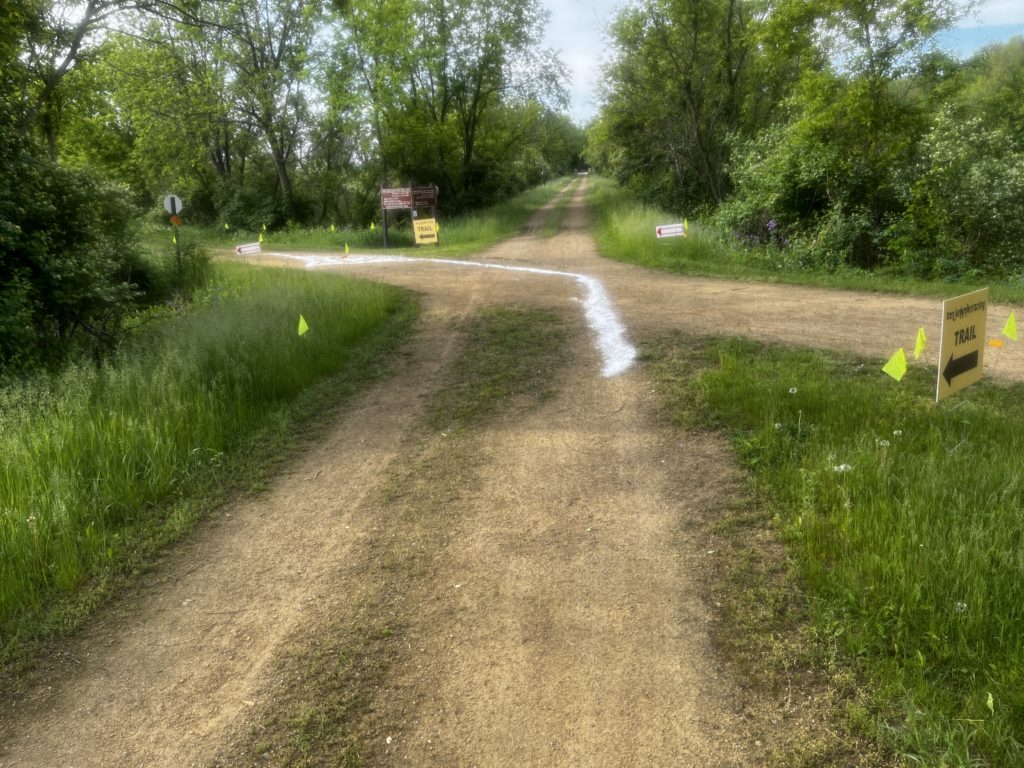
The turnaround aid station (10) was great. They fed me a hot dog. Gave me ice to put in my buff. Took an awesome picture of me. The only problem was I stayed too long! I was there almost 20 minutes!

I knew the second half of the race the temperatures would get higher, so I planned to slow my pace, but I also changed into a new shirt from my drop bag. And I made what I think was the biggest mistake of the day: I changed my socks. As I’m writing this, I am realizing why it was a mistake. I never practiced changing my socks DURING A RUN. It never even crossed my mind to do because I’ve put on socks so many times of course. I have a feeling the problem we’ll get to was caused at least in part by debris being in my sock that I didn’t clean off properly. Within the first mile of the return I knew something wasn’t quite right with my left sock. I stopped a few times to adjust, but it just never was quite right the rest of the time.
I slowed my pace a bit to adjust to the increasing tempeature on the back half. I got through the first aid station (12) without issue (the Flamingo’s were a delight!). Between that aid station (12) and the next (14) my stomach started turning a little bit and I started feeling a bit off. I was starting to get some sloshing in my stomach so I backed off on the fluid intake a little bit. I think at this point I just had slowed my pace down enough that I really wasn’t sweating hard like I normally do and my shirt even felt mostly dry. I was actually a little worreid that I had somehow hit the point where I couldn’t sweat anymore, but I soon figured out that wasn’t the case when I hit a bright spot in the day. So I think I just didn’t need quite as much fluid as I did when I was pushing harder earlier.
The next leg (15) I started to really feel fatigued. I don’t think I ate enough at the first two aid stations on the return trip. I noticed I was starting to check my watch for how much time was left in my run interval more and more. I took my first extended walk break here. This was both annoying, but also super enocouraging. It was about 35 miles when I started to really feel it which is what I thought would happen – so my planning was actually pretty decent. At 35 miles, 17 to go, I knew I would finish as long as I didn’t pass out. On that walk break I did some quick math and figured out that really, sub 11 hours was not going to be possible. I never really thought it was realistic, but the race started so well I didn’t want to write it off either. Now though, it would have been reckless to try to maintain it, so I decided then and there that my goal was to stay to sub 12. The easiest way for me to do that was to look at my overall average pace on my watch. Knowin that the GPS is not perfect, and that the total race distance is ~52 miles, I took a conservative estimate that would have wiggle room and said 13:41 was the average pace I needed to keep to. Math done, I went back to racing, but I adjusted my intervals from 4/2 to 3/3.
At the Hollywood aid station I was greated from afar by a Megaphone yelling “Hey Duck” – again, listen to the podcast. This was a huge pick me up and helped me get there. Stuffed some food in my face, got my special Hollywood Aid Station bandana that was dipped in ice water and wrapped around my neck by THE Holly herself, and then set off with some food in my hand. I walked a little bit then got back to my intervals. At 3/3 I started seeing the average pace start ticking up but I wasn’t worried. Then, about 2 miles into the leg (17) I started feeling a blister on my heel. I thought I felt one on the ball of my foot too, but later inspection would show it was just sore. With 3 miles and change to the next Aid Station and lacking any real means to deal with the blister on my person I just carried on and hoped for the best. With about 2 miles to go, that sucker popped in my shoe. This was a new experience for me altogether – I’ve never had blister issues running, even in the 50K. I really didn’t know what to do, but I was stuck between aid stations so I just sucked it up and kept moving. Later I would talk with folks at the finish about it and learn a lot about blister care. It was an inevitable eventuality, and I’m just glad it happened that late in the race. When I got to the last aid station I realized that between the hill and the blister popping I was starting to get close to the time limit for my 12 hour goal, and I knew I probably wasn’t going to run anymore. So I topped off my water, grabbed some food and headed out (Nikita I owe you a shot still!).
The last leg (19) was really an interesting experience. I was beat up, but not defeated. If anything, I was triumphant. I knew I’d finish and hit my sub 12 goal. It was a very emotional 4 mile walk complete with lots of reflection on why I was doing this in the first place. Certainly not for health reasons anymore – you can even argue that running these distances is almost detrimental to health. I really think I just wanted to prove to myself that I could. It helps that I had a great time doing it. I found something out on the trail that day that’s hard to explain. It’s not satisfaction, or pride, though they are there. Perhaps someone more skilled with words could explain it, but I suspect it is more likely that if you want to know, you’re just going to have to go out and do it too.
Just as I was getting back into Belleville three other runners came up from behind me, seemingly out of nowhere. They were still running and passed me. They ended up crossing the line a few minutes in ahead of me. Good on them – they looked really strong at that point. There’s this little staircase maybe 100 yards from the finish line that’s like a cruel joke, I plodded up it and then turned towards the finishing chute. As I turned onto the last stretch, even though I know I would have finished perfectly fine, I felt compelled to jog in that last little bit. It felt good to cross the finish line running.
Post-race
When I finished Chicago last fall, and even when I finished the 50K a few weeks ago, I was super emotional at the finish line. At the Sugar Badger though, I wasn’t. I was excited and exasperated. I had meant to say something to the RD and take a picture with him, but I was just too out of it. I do think a good portion of that was that I left a lot of that emotion out on the course. Whether it was when I just started bawling listening to Johnny Cash’s Hurt (how did I think that was a good idea?), or just thinking thoughts about how proud I was that I got this far, there really wasn’t much left in the tank at the finish line. In a way, that was nice. I was able to just enjoy the moment more, chat with fellow runners and TJM fans and just have a great post-race celebration with Spotted Cow and pizza.
This race is put on by Ten Junk Miles – which is a runner’s Podcast and race organizer. I got involved in the TJM community after running a half marathon at their Badger Trail Races in August 2021. Having listened to many, many hours of the RD on podcasts, talking with fellow fans on Slack, and slowly but surely starting to follow all those involved on Strava this race became more than just a mileage goal for me. TJM is why I got into trail and ultra running. And though I’m just a generally awkward person who doesn’t know how to talk to people, it was so much fun to get to chat with these folks at the finish line. I hope to do it more!
I think the decision to go with the hip pack and a hand-held was a great call. It prevented me from panic carrying too much stuff and it let my back breathe. The only thing I regret is not finagling a good blister kit into it somehow. I have since looked, and I will experiment with a few options for carrying my trail first aid kit on the belt. Really, with how well the pack worked, I feel like unless I’m on a run where I either need lots of gear, or I’m just on an unsupported long run, I can use this waist pack for the vast majority of my runs.
I was pretty happy with the remaining gear. My shirts, shorts and liner were great. It’s possible the blister was a shoe issue, but I think the blame falls on me for that, so I can’t fault the socks or the shoes (yet).
I’ve got 3 more races I’m registered for this year. Christmas In July, a 24 hour race in Lisle, IL, The Chicago Marathon, and the Tunnel Hill 100. This race has provided so many lessons for me that I’ll need to get through Tunnel Hill for sure. Everything else for the rest of the year revolves around prepping for Tunnel Hill. Christmas In July will be a great training race where I can try and apply the lessons from the Sugar Badger, and get some experience with overnight running. Chicago will be a good long training run. And there’s an overnight 12 hour race in September I might do just for some more overnight practice.
But first, I’m taking a short off-season. No running for 5 days post Sugar Badger and then the next week and a half after only easy runs. In retrospect, I should have taken more of an off-season after the Dopey Challenge. I couldn’t because of what I was registered for and I needed to train, and still, it was a mistake.
Made with a new race report generator created by /u/herumph.

